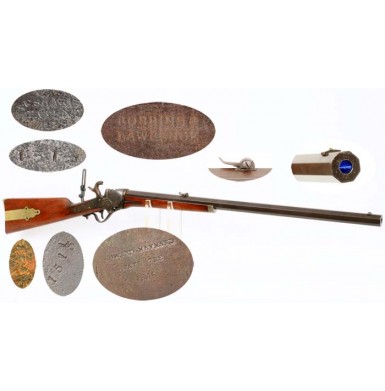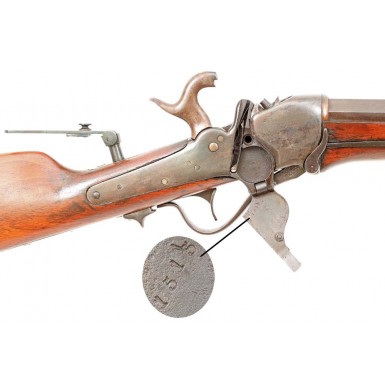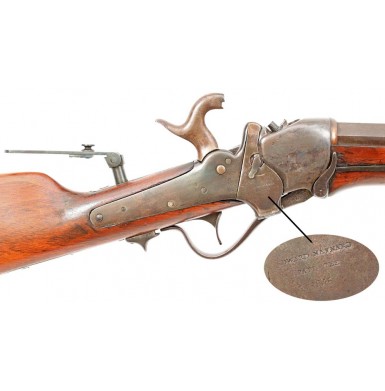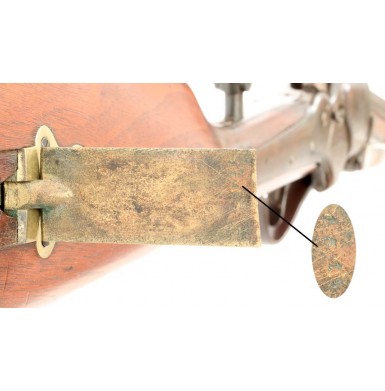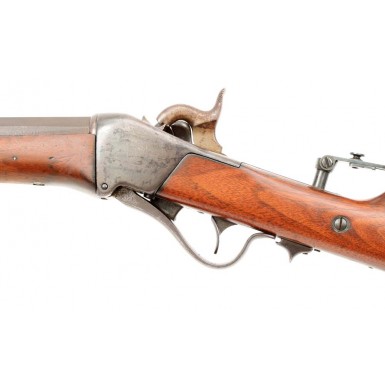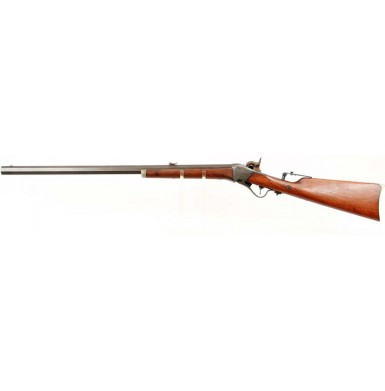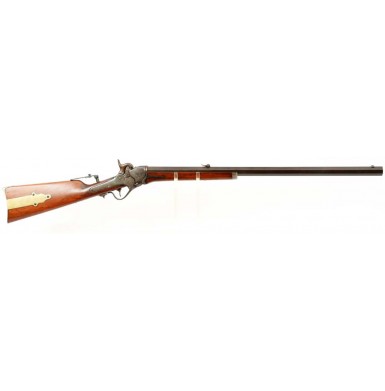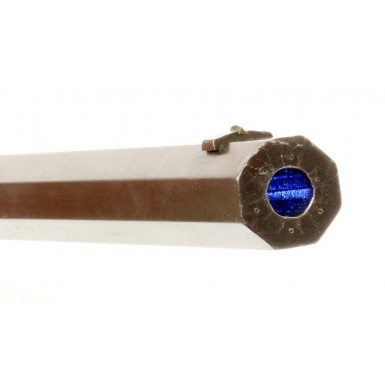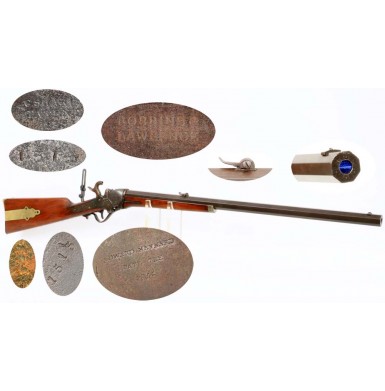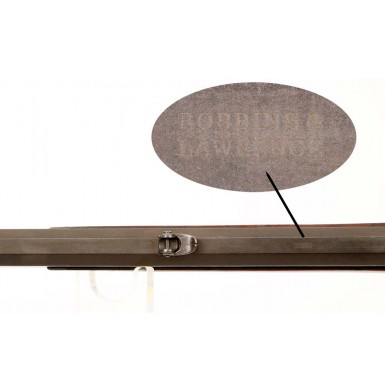Sharps M-1851 Sporting Rifle - Near Fine
- Product Code: FLA-3226-SOLD
- Availability: Out Of Stock
-
$1.00
In November of 1852 the production of the “slant breech” series of Sharps rifles and carbines began. This series of guns would encompass four models, the Models 1851, 1852, 1853 and 1855. These were the first Sharps’ patent guns produced on anything approaching a “large scale”, as the earlier Sharps designs (M-1849 and M-1850) had been manufactured on a very small scale; less than 100 M-1849s and less than 200 M-1850s. It is somewhat disingenuous to say that Christian Sharps, inventor of Sharps breechloading design, holder of the patent rights thereto and namesake of the Sharps Rifle Manufacturing Company was the “designer” of the M-1851. The Model 1851, the first of the “slant breech” Sharps models, was certainly based upon Sharps’ patent and a model he had produced and submitted to his production partners at Robbins & Lawrence. However, it was the modifications to the design added by Richard S. Lawrence and William Jones that resulted in the very unique M-1851 design. The “slant breech” series derive that appellation from a change to Sharps’ initial design affected by Lawrence & Jones. Rather than the sliding breech block engaging the breech face of the barrel at a 90-degree angle, perpendicular to it, they inclined the breech 22 degrees to the rear, resulting in an operating angle of 112-degrees. This inclined plane is clearly evident from the exterior of the gun, as the breechblock is obviously canted to the rear. It would not be until the introduction of Sharps’ New Model 1859 series that the slanting breechblock would be discarded and Sharps would return to his original patent design of a perpendicular breechblock. The M-1851 series of gun utilized the Maynard Automatic Tape Priming mechanism that had been patented by Doctor William Maynard in 1848, and had a unique “box lock” mechanism, with the hammer inside the lock plate, rather than outside the lock. This allowed the bottom portion of the hammer to serve as the tumbler upon which the hammer operated, rather than having a separate tumbler inside the lock that was connected to the hammer outside the lock. This unique arrangement would be abandoned with the M-1852 Sharps designs and the box lock system would not be revisited by Sharps. The M-1851s were produced in both carbine and sporting rifle variations, with a total of about 2,050 produced based upon factory serial number records. Of these less than 200 were rifles (Seller’s cites 193, but notes that the lack of records for 38 serial numbers could cause his number to be incorrect) and the balance were carbines. Of the carbines 150 were delivered on a US Army contract and another 60 were delivered on a Navy contract. The guns were serial numbered sequentially from 1 to 2,050 and were produced from November 1 of 1852 through April 1 of 1855. The M-1851s were produced in three calibers, or rather bore sizes. Sharps rated the guns by bore size, or the number of lead balls that could be cast from a pound of lead for that size of bore. Under that system the larger the “bore” number, the smaller the caliber, and vice versa. The guns cataloged in in 32 bore (nominally about .52 caliber), 60 bore (about .43 caliber) and 90 bore (about .38 caliber). The sporting rifles were offered with either round or octagon barrels in lengths ranging from 18” to 34”, with 27” being the “standard” and most commonly encountered length. The carbines were produced with 21” round barrels. Most carbines were mounted with some variant of a sling bar for mounted carry. All M-1851s were brass mounted with brass patchboxes and buttplates standard and brass barrel bands on most carbines. Some M-1851s were produced without patchboxes, but not many. The rifles typically had pewter forend caps, but some were made without them as well. The standard sights were a fixed front and folding “squirrel ear” shaped rear mounted on the barrels of both rifles and carbines. On the carbine a fixed brass blade was the standard front sight and a fixed globe front sight was standard on the rifles. An additional folding long-range sight was typically mounted on the receiver tang of the rifles as well. Of course special order sights were available for the sporting arms, and both sporting rifles and carbines were available with factory embellishments like high grade wood, standard engraving, “extra” engraving, etc. Factory records only reveal 193 M-1851 Sporting Rifles being produced, and of these the large majority were plain (not engraved) octagon barrel guns. Sharps produced 66 round barreled Sporting Rifles, as well as 126 octagon barrel Sporting Rifles, and one lone oddity; a half-octagon half-round 60 bore Sporting Rifle. Of the M-1851 Sporting Rifles manufactured with octagon barrels, the production distribution was as follows: 10 were 32 bore (all plain), 66 were 60 bore (of which 53 were plain, 6 were engraved and 7 were “extra” engraved) and 47 were 90 bore (of which 41 were plain, 2 were engraved and 4 were “extra” engraved). Even though the M-1852 and M-1853 series of arms had been introduced during the latter part of M-1851s production life, the M-1851 was manufactured in limited quantities through the first quarter of 1855, at which time the production of the “box lock slant breech” came to an end.
Offered here is a rare Sharps M-1851 Sporting Rifle. The is a plain (not engraved) rifle with a 27” octagon barrel and appears to be 60 bore. That makes it one of only 53 such rifles produced by Sharps between late 1852 and early 1855. The gun is serial number 1515, placing it in the latter portion of the M-1851 production. The gun is brass mounted with a patchbox, has a pewter forend cap and an early production Sharps long-range tang sight, mated with a simple dovetailed front sight, rather than the more commonly encountered globe front sight. An M-1851 Sporting Rifle in the exact same configuration is pictured on page 42 of Frank Sellers’ Sharps Firearms. In the photo of five 1851 pattern Sharps rifles, it is the gun in the bottom of the picture, and may even be this exact same rifle. The gun is in about VERY GOOD+ to NEAR FINE overall condition, with the metal being in somewhat better shape than the wood. As noted the rifle is serial number 1515 and this number is found on the tang of the receiver, as well as the bottom of the barrel, inside the patchbox, on the “inside” of the buttplate, inside the Maynard Tape Primer door, on the inside of the trigger plate, on the rear face of the breech block and on the inside face of the lock itself. The receiver tang of the rifle is marked in three lines: C. SHARPS / PATENT / 1848, but the mark is very difficult to read due to pitting, wear and flash erosion to the metal in this area. The barrel is crisply marked in two lines between the rear sight and the breech: ROBBINS & / LAWRENCE. The exterior of the tape primer door is marked in three lines: EDWARD MAYNARD / PATENTEE / 1845 and is stamped with the serial number inside. The markings are mostly legible, but are slightly worn due to erosion from the caustic, mercuric primer residue. The barrel has a smooth plum brown patina that is very attractive, and has traces of the original lacquer browned finish underneath where the forend has protected it. The barrel is mostly smooth with only some scattered pinpricking here and there, primarily around the muzzle and the breech, where some light pitting is present as well. The bore of the rifle remains in VERY GOOD+ condition. The bore measures .461” from land to land and about .470” groove to groove. Even though the gun is is a 60 bore rifle (nominally about .425 caliber), variations in bore size are quite common in Sharps rifles of the era. The gun is clearly too large a bore to be a 90 bore (about .37 caliber) and too small to be a 32 bore (about .52 caliber). The 6-groove rifling is deep and remains very crisp and sharp the entire length of the bore. The bore is somewhat dark and dirty with light pitting along its entire length with some scattered patches of more moderate pitting present as well. The receiver of the rifle has a mottled plum brown patina over most of the surfaces, with hints of the original case coloring. Patches of muted blues and purples are still visible on the receiver. There is some light pitting on the receiver and some more moderate pitting around the loading area of the breech and the tang. The breech block shows some light to moderate pitting externally and more moderate erosion internally. The platinum breech block ring remains in place in the face of the breech, a part normally missing when these scarce rifles are found today. The operating lever retains some traces of its original blued finish with a deep, darky smoky plum brown patina. The lever operates smoothly and the block opens and closes as it should. The lever catch at the rear of the triggerguard plate operates smoothly and correctly as well. The lock mechanism also functions well, and all of the components for the Maynard Tape Priming system are present and the system works perfectly. The hammer cocks crisply into all three notches, safety, half-cock and full-cock. The hammer responds to the trigger at both full and half cock as it should, as the half-cock notch was for capping the cone if the priming mechanism was not in use, and the hammer was then to be lowered to the safety notch. The original dove tailed blade front sight is in place on the end of the barrel near the muzzle, along with the small “squirrel ear” shaped rear sight on the barrel, forward of the breech. The original Sharps factory long-range tang sight is in place on the receiver tang and is complete and functional. The receiver sight retains some strong traces of its original brilliant blued finish. The brass buttplate and patchbox cover both have a very nice, rich golden patina. Both parts show an accumulation of dark green verdigris where they have contacted the wood for such a long period of time. The wood of the rifle is in nice condition and is quite attractive. As is often the case with rifles this old and with such heavy barrels, some repairs are found in the butt stock and forend. The rates about NEAR VERY GOOD as repaired and lightly refinished. The butt stock shows the usual repair to a chip out of the toe near the bottom edge of the buttplate. There is also a repair to a repair between the breech tang and the upper rear of the lock plate. The butt stock has been lightly sanded and refinished, and both the repair near the lock and the toe chip are barely noticeable. The forend is in similar condition with a repair to a missing chip of wood where the forend meets the receiver. The forend was also lightly sanded refinished, and again the quality work make the minor repair barely noticeable. Both the butt and forend also show some lightly scattered bumps and dings, but these are minor and hardly worthy of mention. The wood repair sound worse than they really are, but are mentioned for exactness. The pictures below show how attractive the rifle is and how expertly the repairs were made, so that they do not detract from the display of this scarce, early Sharps rifle.
Overall this is a very nice example of a rather scarce Sharps M-1851 Sporting Rifle, of which only 53 were produced in 60 bore with octagon barrels and without engraving. The metal has a lovely patina and coloration to it and the rifle displays very well. The description makes the wood repairs sound worse than they look, and you can see from the photos that the wood still displays well. For any serious Sharps collector a M-1851 is a must have item, as it is the first really attainable of the Sharps firearms (the M-1849s and M-1850s simply do not come up for sale very often at all). These are rare guns and historically important as well. When researching comparable sales, I found that the last couple of recorded M-1851 Sporting Rifle sales in comparable condition sold in the low five-figure price range. This gun is a little more reasonably priced and will certainly be an outstanding addition to your advanced collection of Sharps long arms.
SOLD
